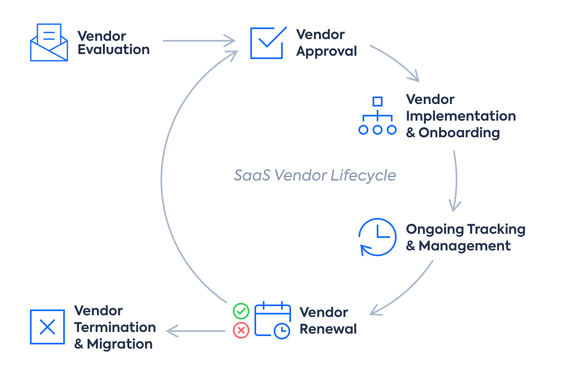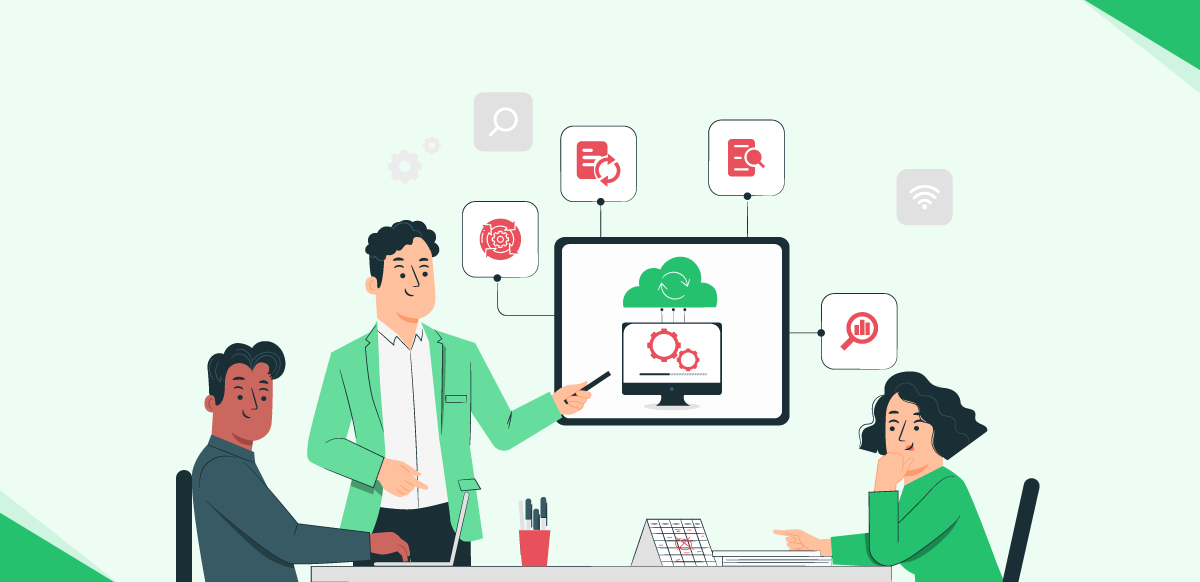Cloud technology is taking the world by storm. As a result, more and more businesses rely on the popular Software-as-a-Service (SaaS) tools to deliver the best IT solutions.
Do you know that companies having more than 1,000 employees use more than 150 SaaS applications?
However, this growth of SaaS can backfire easily when not appropriately managed at different levels in the business. Hence, companies soon realize the urgent need for SaaS lifecycle management.
What is SaaS (Vendor) Lifecycle Management?

The SaaS vendor lifecycle management is a detailed process of managing and overlooking your SaaS tools and the vendors to maximize operational efficiency. For managing different SaaS applications effectively-currently and in the coming future, businesses need to develop a dedicated SaaS lifecycle management strategy. It should be an open and flexible strategy that meets the SaaS applications’ short & long term business goals.
You May Also Read : Connect ControlHippo to Hubspot Integration in 2 Minutes
What is SaaS Vendor Management Process?

The SaaS vendor management process is the strategy in which the relationship between the supplier and the SaaS vendor remains intact. This helps the IT sector with every problem they face with SaaS vendors and tools. Ultimately, it can also help companies develop a customized app related to it to streamline the whole SaaS lifecycle operations.
What is the SaaS Vendor Lifecycle?
Effective SaaS vendor management is an integral part of lifecycle management as businesses use multiple SaaS applications from different vendors. Let us check the need for vendor lifecycle management for SaaS applications first.
Vendor Management Process

Any product lifecycle management has exemplary results in end-to-end application management, controlling costs, and managing different risks. SaaS vendor management is the detailed strategy that helps businesses manage other SaaS vendors and supplier relationships.
This process aims to locate the best IT solution, manage them, keep strict tracking and rigorous monitoring, and optimize the total expenses.
7 Steps to address SaaS Lifecycle are:
Step 1: Evaluation
Before starting the search for SaaS vendors, businesses need to evaluate the current SaaS requirements. For example, is it for a new business process, or is it a part of the SaaS upgrade?
Once the SaaS applications need is established, it is time to evaluate the existing SaaS vendors. Businesses often observe that the current vendors can satisfy the new SaaS needs, and hence there is no need to go for the new vendors.
The leading SaaS sales marketplaces or Google can help businesses connect to the new SaaS vendors if the previously onboarded can’t satisfy the current needs. Hence, SaaS vendor evaluation is the first step in dedicated SaaS vendor management.
Step 2: Price Negotiation
This is one of the essential parts of the vendor management process. When thinking of any new contract, the company has to think of the budget, so negotiation is necessary. With the help of this, the company can settle down all its required apps based on their requirements.
Step 3: Procurement And Approvals
After going through the available options in the SaaS vendors, it becomes easy for businesses to settle for a single service provider. However, once done, it is time for the detailed assessment of the vendor by different departments, including the IT team, information security, procurement, etc.
Before finalizing the contract, the SaaS vendor hiring and approval process starts. It includes clearing terms and conditions, SaaS metrics ,cross-checking renewal dates, generating queries, etc. It is an essential part of the SaaS vendor lifecycle as it locks a service provider with the business.
Step 4: Implementation And Onboarding
The next step is SaaS implementation and vendor onboarding. Businesses convey the expected process speeds, application expectations, goals, and timelines so that these can be implemented in line with the same only.
Further, it is necessary to integrate the upcoming SaaS application from a new vendor with the existing SaaS tools used in the business.
The application owner is established within the organization, initial vendor adoption is tracked, and all possible changes are communicated to the end-users. Finally, it completes the implementation part of the SaaS vendor management.
Step 5: Management And Tracking
The following line is one of the most extended steps in managing the SaaS vendor lifecycle. It can vary from one business to the other based on their processes and involves different steps, including
- Storing vendor details,
- Tracking SaaS usage,
- Managing security policies,
- Managing contracts and agreements, and
- Optimizing communication flows with SaaS vendors.
The results from these steps give way to the end of the SaaS vendor management, which can be the renewal or exit of the SaaS vendors.
Step 6: Renewals
Businesses always have the option to renew an existing contract with the SaaS vendor or migrate to a new vendor towards the end of an existing subscription.
The company’s software renewal strategy and SaaS spend management can be the decision-makers that help businesses evaluate their decision of renewal or migration.
Renewal in the vendor lifecycle includes re-negotiations, loyalty discounts, and recognizing the correct number of licenses. If renewals are not a feasible option, it ends with the safe exits of the SaaS vendors.
Step 7: Safe Exits
All SaaS vendors’ exits should be safe, adhere to compliances, and be cost-effective. The essential points to consider during safe exits include:
- Preventing loss of crucial data,
- Ensuring no security risks from off-boarded applications, and
- Such applications can’t re-enter the company in shadow IT.
Hence, the vendor lifecycle ends with a smooth transition plan for the safe exit of the SaaS vendors under guided compliances and reduced SaaS security risks.
Why is the SaaS Product Development Life Cycle Important?

While no two businesses can have the same modus operandi, it all comes down to the type of processes or applications used in the processes. Therefore, the SaaS product lifecycle management is crucial for any business due to the following key reasons:
1. Reduced Operational Efficiencies
SaaS vendors may sell their applications based on the increased efficiencies over the traditional on-premise versions, but a thorough look reveals the other side of the story. With an increasing number of SaaS subscriptions, the IT departments feel burdened to manage all the applications, making their daily work complex. As a result, IT teams spend more time managing different vendors than working on the much-needed IT core technologies.
Hence, SaaS product lifecycle management can rescue businesses from reduced operational efficiencies. All SaaS applications are rationalized or consolidated to reduce ticket support and improve the IT team’s efficiency.
2. Unnoticed SaaS Vendor Renewals
Multiple SaaS vendors in the market fail to notify the businesses in advance about the ending subscriptions. Hence, companies must pay the late fees and any increased subscription amounts. This is the strategy of the SaaS vendors to keep auto-renewals running, which may soon become a downside for the businesses.
The SaaS application lifecycle management, on the other hand, comes with dedicated renewal calendars. Hence, it becomes easy for the IT teams to track the upcoming SaaS renewal and forecast future spending. Further, promoting the SaaS accounting within its lifecycle management helps businesses reduce the chances of shadowing IT.
3. Security Risks
SaaS applications are assessed online, and hence all the systems and devices using these applications are prone to online data breaches. While IT teams may be aware of the possible phishing or hacking attempts, it becomes difficult to manage different SaaS applications individually. Hence, all companies’ sensitive information like client details may come on the verge of online access due to the minimalist loopholes in the system.
The SaaS vendor management comes with detailed training on risk mitigation for employees. Thus, businesses can keep a strict vigil on the increased SaaS purchases and significantly improve the SaaS security for multiple applications.
Businesses bifurcate SaaS purchases to different team members. However, not soon do they realize that even the non-IT teams are leading the SaaS purchases, which contribute to the shadow IT risks. In addition, with the increased workforce, the SaaS applications started overlapping with an increasing number of onboard vendors.
The SaaS lifecycle m SaaS product development lifecycle management only takes charge of SaaS discovery during the vendor evaluation process. Hence, the increased visibility in the SaaS purchases reduces the operational costs and eliminates the overlapped assets. No more remote SaaS purchases when all the details of the onboard SaaS vendors are collected at one platform only.
5. Wasted SaaS Applications
While onboarding, purchase, and managing are the main issues for SaaS subscriptions, overspending is another primary concern. During the renewal and spend optimization processes, businesses realize the wastage of specific SaaS applications for various reasons.
Hence, the vendor lifecycle for all SaaS applications needs to be implemented at the right time to avoid waste of money and time. The annual SaaS expenses management and vendor ratings can help businesses go for the ones bringing the best for the business processes. Moreover, it becomes easy to get the optimized value of the SaaS expenses with detailed SaaS to spend optimization.
5 Stages of the SaaS Lifecycle
- Mapped – First, you need to map an application into your system to help the employees work in an alignment.
- In Review – In this stage, you need to acquire the employees’ feedback; this will help you get the review of that app.
- Adopt – Once the app has been passed, you need to sanction it from everywhere on your IT, or else, you will not be able to use it.
- Optimization – Once you have adopted a SaaS application, you need to optimize the app’s cost and utilization for the best outcome.
- Retire – When the app finds no more work, you need to stop using that app. This is also important, as other better apps are coming now and then; it helps adopt new apps.
SaaS Vendor Management Best Practices

Having learned why SaaS vendor management is so important, we will consider some best practices for scaling your own SaaS vendor management system. Combined with a vendor management platform that offers automated tools, these best practices can help you manage and procure vendors efficiently, allowing your organization to thrive in a cloud-first world.
1. Maintain Consistency In Ownership And Inventory
Since virtually anyone can purchase SaaS applications without IT department approval; anyone can become a software owner. Unfortunately, even though it’s better to have a few owners, most companies don’t follow this option.
In vendor and SaaS software management , keeping ownership consistent is essential. Along with picking the right owner, keeping track of your vendors’ information is equally important. In addition to promoting accountability, it saves time in future cases of vendor changes if all information can be retrieved rapidly.
2. Renewals Can Be Proactive
Unreviewed SaaS renewals are a significant cause of overspending on SaaS and bloated SaaS portfolios, as described earlier in this guide. In addition, SaaS contracts and SaaS vendor management are so complex that it’s hard to pinpoint when the renewal is scheduled due to the number of SaaS contracts and moving parts.
Therefore, if you plan to renew, adhere to best practices, and have a comprehensive renewal calendar, you’ll have plenty of time to look at renewal patterns and unused licenses and prepare for new negotiations.
3. Conduct SaaS Audits As Part Of Governance
As well as allowing for SaaS discovery, and visibility, SaaS subscription management platforms will enable you to implement SaaS governance. For example, a vendor management cycle should be governed by IT governance to establish authorization and permissions.
Along with setting up a good governance plan, performing regular SaaS audits (quarterly or biannually) is also a good idea. It is essential to talk to the end-users to determine which apps are used daily, which are redundant, and whether employees are already using free tools as a substitute for paid versions.
4. Analyze Usage
This best practice is often overlooked because it is ongoing and never truly completed. However, a detailed analysis of SaaS usage within your organization can give you helpful insight into how business users utilize SaaS applications and how much value is created or wasted.
When you know how many saas licenses you need and which additional software features are unnecessary, you can negotiate with vendors more effectively and ultimately get a better deal. Through SaaS management platforms, SaaS spend optimization is only possible.
You May Also Read : Connect ControlHippo to ZOHO Integration in 2 Minutes
How ControlHippo Helps With SaaS Vendor Management?
ControlHippo can help you reduce SaaS spending by 20% by helping you lower your SaaS wastage. It checks all the four practices mentioned earlier while producing frictionless monitoring to help make swift decisions.
Your SaaS management cloud software should provide you with the visibility you need to see which applications your team uses, how often they do it, and how it impacts your business. And ControlHippo offers you just that. So start tracking within minutes.
ControlHippo’s SaaS Management Tool rationalizes your portfolio and eliminates duplicate apps. In addition, it detects different apps according to their usage, giving you 100% efficiency. As a result, you can acquire a holistic view of your organization’s SaaS Management, manage subscriptions, bargain contracts, and eliminate waste.
Wrapping Up
With more than 73% of the businesses migrating to SaaS in 2021 globally, there are no limitations to the available SaaS vendors. Hence, it is crucial for companies using multiple SaaS applications to implement an effective SaaS lifecycle management strategy.
It reduces the potential risks of the unmanaged SaaS, which include uncontrolled costs, shadows IT , product-led reduced efficiencies, etc.
The steps to manage a SaaS vendor’s lifecycle further ensures that no vendor gets unnoticed in SaaS purchases, increases security risks, unreviewed renewals, etc. It starts with an evaluation, vendor procurement, approvals, onboarding end-to-end management, renewals, and safety exits.
Hence whether in cloud-first environments or managing the growing number of SaaS applications, it is easy to increase the IT team efficiency by implementing dedicated SaaS lifecycle management strategies.
Updated : February 6, 2024

Subscribe to our newsletter & never miss our latest news and promotions.



